Hi,
I've been trying to figure this problem out for three months, and unfortunately, I'm still at the same place where I started.
I'll try to summarize what's my objective and my result:
My main soft-body object is a stomach. I created little sphere colliders in the place of obi particles. Then, I shoot a ray from my pulling device and find the picked particles. I assign these particle indices to my pulling device as a particle attachment group and prevent the other particles' movement(basically, I create another particle attachment and specify the particle group to a static position). When I do that, I have this mesh deformation problem. I see triangles and it doesn't look smooth. Here is an example picture:
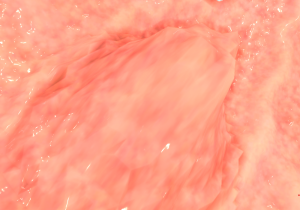
Before you comment, I'd like to say that I've tried various techniques. I played all the parameters(Obi Softbody Skinner, Obi Solver, Shape matching constraints), tested different blueprint resolutions, and finally, tested with different mesh vertex counts. I also tried a combination of these solution techniques. But, the result was always similar to the picture.
Furthermore, I tested without limiting particle behavior(I assigned the picked-particle group to the pulling device but didn't limit other particles' movement). This time, the whole mesh was affected by the soft body, but my objective was to simulate a focused group of particles solely.
I'll share my current parameters with you here, I look forward to your help to cease or reduce the pixelation problem. I post extra information if you need it.
Current Parameters:
Obi Version: 6.4
Vertex Count of the Stomach: 32k
Softbody Skinner
Softbody Influence:0.7
Max Bones Per Vertex:28
Skinning Falloff:0.8
Skinning Max Distance:0.22
Shape Matching Constraints
Deformation resistance:0.207
Max Deformation:0.875
Plastic Yield: 100
Plastic Creep: 100
Plastic Recovery:500
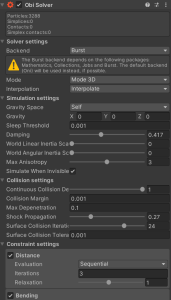
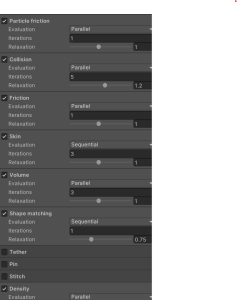
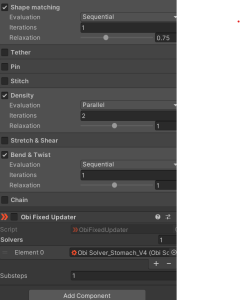
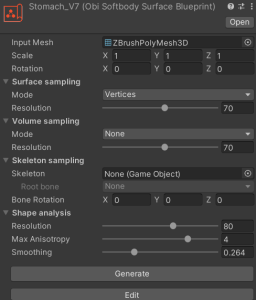
I've been trying to figure this problem out for three months, and unfortunately, I'm still at the same place where I started.
I'll try to summarize what's my objective and my result:
My main soft-body object is a stomach. I created little sphere colliders in the place of obi particles. Then, I shoot a ray from my pulling device and find the picked particles. I assign these particle indices to my pulling device as a particle attachment group and prevent the other particles' movement(basically, I create another particle attachment and specify the particle group to a static position). When I do that, I have this mesh deformation problem. I see triangles and it doesn't look smooth. Here is an example picture:
Before you comment, I'd like to say that I've tried various techniques. I played all the parameters(Obi Softbody Skinner, Obi Solver, Shape matching constraints), tested different blueprint resolutions, and finally, tested with different mesh vertex counts. I also tried a combination of these solution techniques. But, the result was always similar to the picture.
Furthermore, I tested without limiting particle behavior(I assigned the picked-particle group to the pulling device but didn't limit other particles' movement). This time, the whole mesh was affected by the soft body, but my objective was to simulate a focused group of particles solely.
I'll share my current parameters with you here, I look forward to your help to cease or reduce the pixelation problem. I post extra information if you need it.
Current Parameters:
Obi Version: 6.4
Vertex Count of the Stomach: 32k
Softbody Skinner
Softbody Influence:0.7
Max Bones Per Vertex:28
Skinning Falloff:0.8
Skinning Max Distance:0.22
Shape Matching Constraints
Deformation resistance:0.207
Max Deformation:0.875
Plastic Yield: 100
Plastic Creep: 100
Plastic Recovery:500





![[Image: NdVQwIP.png]](https://i.imgur.com/NdVQwIP.png)
![[Image: K51On2D.png]](https://i.imgur.com/K51On2D.png)